Religion in Armenia
 From Wikipedia - Reading time: 18 min
From Wikipedia - Reading time: 18 min
Religious makeup of Armenia, according to the 2022 census.[1]
As of 2011, most Armenians in Armenia are Christians (97%)[2] and are members of the Armenian Apostolic Church, which is one of the oldest Christian churches. It was founded in the 1st century AD, and in 301 AD became the first branch of Christianity to become a state religion.
Demographics
[edit]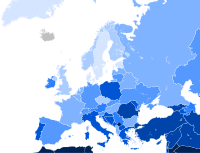
Approximately 98.1% of the country's population is ethnically Armenian, the vast majority of whom belong to the Armenian Apostolic Church.[1]
According to a survey done by the Pew Research Center, 51% of adults in Armenia are "highly religious", and the survey ranked Armenia as the second-most religious out of 34 European countries, after Romania. 79% of Armenians surveyed reported that they believe in God with "absolute certainty", and 53% consider religion very important in their lives.[3]
| Religion | Population (2011)[2] | Population (2022)[1] | ||
|---|---|---|---|---|
| Total population | 3,018,854 | 2,932,731 | ||
| Armenian Apostolic Church | 2,797,187 | 2,793,042 | ||
| Catholicism | 13,996 | 17,884 | ||
| Evangelicalism | 29,280 | 15,836 | ||
| Yezidism | 23,374 | 14,349 | ||
| Orthodoxy | 7,587 | 6,316 | ||
| Jehovah's Witnesses | 8,695 | 5,282 | ||
| Paganism | 5,416 | 2,132 | ||
| Molokan | 2,874 | 2,000 | ||
| Nestorian Church | 1,733 | 524 | ||
| Islam | 812 | 515 | ||
| Hare Krishna | - | - | 204 | |
| Judaism | - | - | 118 | |
| Other Protestant | 773 | - | - | |
| Mormon | 241 | - | - | |
| Other | 5,299 | 7,675 | ||
| None | 34,373 | 17,501 | ||
| Refused to answer | 10,941 | 49,353 | ||
| Unspecified | 76,273 | - | - | |

Geographic distribution
[edit]Yazidis are concentrated primarily in agricultural areas around Mount Aragats, northwest of Yerevan. They live in 19 villages in the Aragatsotn Province, two villages in the Armavir Province, and one village in the Ararat Province.
Armenian Catholics live mainly in the northern region, in seven villages in the Shirak Province and six villages in the Lori Province.
Molokans live in 10 villages in the Lori Province, two villages in the Shirak Province, and two villages in the Gegharkunik Province.
Most Jews, Mormons, followers of the Bahá'í Faith, Eastern Orthodox Christians, and Latin Catholic Christians reside in the capital Yerevan, which has attracted a greater variety of peoples. Yerevan also has a small community of Muslims, including ethnic Kurds, Iranians, and temporary residents from the Middle East. Foreign missionary groups are active in the country.
Freedom of religion
[edit]The Constitution as amended in 2005 provides for freedom of religion and the right to practice, choose, or change religious belief. It recognizes "the exclusive mission of the Armenian Church as a national church in the spiritual life, development of the national culture, and preservation of the national identity of the people of Armenia." The law places some restrictions on the religious freedom of religious groups other than the Armenian Church. The Law on Freedom of Conscience establishes the separation of church and state but it grants the Armenian Church official status as the national church.
Traditional Armenian religions
[edit]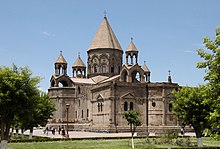
Armenian Apostolic Church
[edit]
According to tradition, Christianity was first introduced to this area by the apostles Bartholomew and Thaddeus in the 1st century AD.[4] Armenia became the first country to establish Christianity as its state religion when, in an event traditionally dated to 301 AD, St. Gregory the Illuminator convinced Tiridates III, the king of Armenia, to convert to Christianity. Before this, the dominant religion was Armenian paganism.
The Armenian Apostolic Church is the national church of the Armenian people. Part of an Eastern Christian denomination in communion with other Oriental Orthodox churches, it is one of the most ancient Christian institutions.[5] And is "seen by many as the custodian of Armenian national identity".[6] "Beyond its role as a religious institution, the Apostolic Church has traditionally been seen as the foundational core in the development of the Armenian national identity as God's uniquely chosen people."[7]
Hetanism
[edit]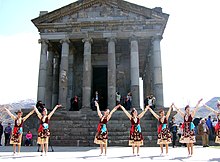
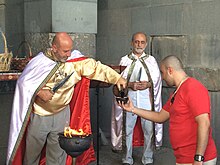
Hetanism (Հեթանոսություն, Hetanosutyun) is a neo-pagan movement in Armenia. Adherents call themselves "Hetans" (Hetanos հեթանոս, the Old Armenian biblical term loaned from Greek ἐθνικός "gentile"). The movement traces its origins back to the work of the early-20th-century political philosopher and revolutionary Garegin Nzhdeh and his doctrine of tseghakron (rejuvenation through national religion). In 1991, it was institutionalized by the Armenologist Slak Kakosyan into the "Order of the Children of Ari" (Arordineri Ukht). The movement is strongly associated to Armenian nationalism. It finds some support from nationalist political parties of Armenia, particularly the Republican Party of Armenia and the Union of Armenian Aryans.[8]
Other Christians and other religions
[edit]Other Christian denominations
[edit]Catholic Church
[edit]The Catholic Church in Armenia is divided between Latin Church parishes (subject to the Apostolic Administration of the Caucasus) and the Armenian Catholic Church's parishes. The 2011 census counted 13,996 Catholics.
Protestantism
[edit]Since the end of the Soviet Union, American Protestant missionaries have been proselytising in the country. The 2011 census counted 29,280 Evangelicals (1% of the population) and 773 other Protestants.
Eastern Orthodoxy
[edit]
According to the Census of 2011, there are 7,587 adherents of Eastern Orthodoxy in Armenia, mainly Russians, Ukrainians, Georgians and Greeks.[2] Russian Orthodox community is centered around Church of the Intercession of the Holy Mother of God in Yerevan, consecrated in 1912.
Molokans
[edit]
The Molokans, a Russian religious group who reject church hierarchy and some Russian Orthodox practices, have a presence in Armenia dating from the early 19th century. Armenian Molokans have low intermarriage rates, and are generally educated in Russian-language schools; most are fluent in both Russian and Armenian.[9] Molokans maintain a communal identity,[10] and rural Molokan villages continue with a traditional lifestyle.[11] The 2011 Armenian census counted 2,874 Molokans[2] and the 2022 census counted 2,000 Molokans.[1]
In 1802, Alexander I ordered that adherents of religious sects should be relocated to southern areas of the Russian Empire; Armenian regions such as Lori, Lake Sevan, Dilijan, and Zangezur were chosen for new Russian settlements. Mass migration of Molokans (as well as Doukhobors, Khlysts, and Skoptsy) to the Caucasus took place in the 1830s, when Nicholas I focused efforts on resettlement, particularly to Armenia.[12] 19th-century Molokan settlements include the villages of Vorontsovka, Nikitino, Voskresenovka, Privolnoye, Elenovka, Semyonovka, Nadezhdino, and Mikhailovka.[13]
The Molokans of Armenia supported the establishment of the Soviet Union, and were active in the Revolutionary movement. Soviet dekulakization policy in the 1920s caused discontentment among the Molokans, and some wanted to emigrate to Russia or Persia; eventually, most chose to stay in Soviet Armenia.[14] Beginning in the 1930s Molokans migrated in large numbers to cities due to collectivization of rural land.[9]
Nestorianism
[edit]According to the Census of 2011, there are 1,733 Nestorians in Armenia.
Restorationism
[edit]The Jehovah's Witnesses have estimated their membership at 11,500; the 2011 census found 8,695.[2]
The Church of Jesus Christ of Latter-day Saints claims approximately 3,000 adherents in Armenia at the end of 2011; the 2011 census found 241.[2][15]
Yazidism
[edit]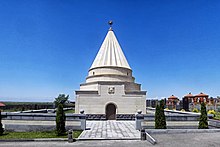
About 1% of Armenia's population (23,374 as per the 2011 census), mostly ethnic Yazidis, an ethno-religious group living in the western part of the country, follow Yazidism. Many Yazidis came to Armenia and Georgia during the 19th and early 20th centuries to escape religious persecution. Relations between Yazidis and Armenians are strong. The world's largest Yazidi temple Quba Mêrê Dîwanê is constructed in the small village of Aknalich.[16]
Judaism
[edit]Currently there are an estimated 750 Jews in the country, a remnant of a once larger community. Most left Armenia for Israel after the collapse of the Soviet Union in pursuit of better living standards. Still, despite the small numbers, high intermarriage rate and relative isolation, a lot of enthusiasm exists to help the community meet its needs.[17]
Islam
[edit]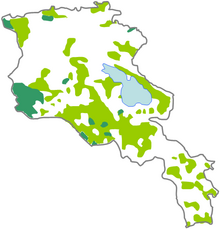
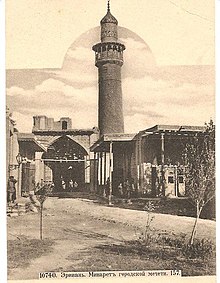
Azerbaijanis and Kurds living in Armenia traditionally practised Islam, but most Azerbaijanis, who were the largest minority in the country, fled during the First Nagorno-Karabakh War.[18][19] In 2009, the Pew Research Center estimated that less than 0.1% of the population, or about 1,000 people, were Muslims.[citation needed]
The 18th century Blue Mosque is open for Friday prayers.
Throughout history, Armenians did not convert to Islam in large numbers despite long periods of Muslim rule. During the Arabic conquest, Islam came to the Armenians; however, very few Armenians converted to Islam, since Christians were not required to convert by Muslim law.
There is, however, a minority of ethnic Armenian Muslims, known as Hamshenis, the vast majority of which live outside of Armenia mostly in Turkey.
Baháʼí Faith
[edit]The Baháʼí Faith in Armenia begins with some involvements in the banishments and execution of the Báb,[20] the Founder of Bábism, viewed by Baháʼís as a precursor religion. The same year of the execution of the Báb the religion was introduced into Armenia.[21] During the period of Soviet policy of religious oppression, the Baháʼís in Armenia lost contact with the Baháʼís elsewhere.[22] However, in 1963 communities were identified[23] in Yerevan and Artez.[24] Following Perestroika, the first Baháʼí Local Spiritual Assemblies of Armenia form in 1991[25] and Armenian Baháʼís elected their first National Spiritual Assembly in 1995.[24]
Hinduism
[edit]With shared interests in many aspects, Indians and Armenians established economic and cultural ties almost 4000 years ago. Per the writings of Zenobius Glak, an early classical Armenian writer, two princes and their families fled to Armenia in 149 BC. They were granted a grand welcome and given land there. They built a temple for Hindu gods and goddesses in Ashtishat, a famous religious center in Armenia. Eventually, their society grew to 20 villages and was called Hindkastan, the Armenian name for India. At one time, there were over 15,000 Hindus living in Armenia.[26]
See also
[edit]References
[edit]- ^ a b c d Republic of Armenia Census (Report). Statistical Committee - Republic of Armenia. 2022. Table 5.5.
- ^ a b c d e f Republic of Armenia Census (PDF) (Report). Statistical Committee - Republic of Armenia. 2011. p. 7.
- ^ Evans, Jonathan; Baronavski, Chris (5 December 2018). "How do European countries differ in religious commitment?". Pew Research Center.
- ^ Curtin, D. P. (January 2014). The Martyrdom of St. Bartholomew: Greek, Arabic, and Armenian Versions. Dalcassian Publishing Company. ISBN 9798868951473.
- ^ Augusti, Johann Christian Wilhelm; Rheinwald, Georg Friedrich Heinrich; Siegel, Carl Christian Friedrich. The Antiquities of the Christian Church. p. 466.
- ^ "Armenian Apostolic Church". Encyclopædia Britannica.
- ^ Terzian, Shelley (2014). "Central effects of religious education in Armenia from Ancient Times to Post-Soviet Armenia". In Wolhuter, Charl; de Wet, Corene (eds.). International Comparative Perspectives on Religion and Education. AFRICAN SUN MeDIA. p. 28. ISBN 978-1-920382-37-7.
- ^ Yulia Antonyan. Re-creation of a Religion: Neopaganism in Armenia. Yerevan State University. This and other papers about Armenian Hetanism are available here.
- ^ a b Haytian 2007, pp. 34–35
- ^ Haytian 2007, p. 36
- ^ Haytian 2007, p. 43
- ^ Haytian 2007, pp. 36–37
- ^ Haytian 2007, p. 37–39
- ^ Haytian 2007, pp. 41–43
- ^ "Statistics and Church Facts | Total Church Membership". newsroom.churchofjesuschrist.org.
- ^ Sherwood, Harriet (25 July 2016). "World's largest Yazidi temple under construction in Armenia". The Guardian. Retrieved 31 July 2016.
- ^ Advocates on Behalf of Jews in Russia, Ukraine, the Baltic States, and Eurasia: Armenia and Jews Archived 2012-05-22 at the Wayback Machine
- ^ International Protection Considerations Regarding Armenian Asylum-Seekers and Refugees Archived 2014-04-16 at the Wayback Machine. United Nations High Commissioner for Refugees. Geneva: September 2003
- ^ Country Reports on Human Rights Practices – 2003: Armenia U.S. Department of State. Released 25 February 2004
- ^ Quinn, Sholeh A. (2009). "Aqasi, Haji Mirza ('Abbas Iravani)(c. 1783–1849)". In Morrison, Gayle (ed.). the Baháʼí Encyclopedia Project. Vol. Online. National Spiritual Assembly of the Baháʼís of the United States.
- ^ Balci, Bayram; Jafarov, Azer (2007-02-21), "The Baháʼís of the Caucasus: From Russian Tolerance to Soviet Repression {2/3}", Caucaz.com, archived from the original on 2008-08-15
- ^ Effendi, Shoghi (1936-03-11). The World Order of Bahá'u'lláh. Haifa, Palestine: US Baháʼí Publishing Trust, 1991 first pocket-size edition. pp. 64–67.
- ^ Monakhova, Elena (2000). "From Islam to Feminism via Baháʼí Faith". Women Plus…. Vol. 2000, no. 3.
- ^ a b Hassall, Graham. "Notes on Research on National Spiritual Assemblies". Research notes. Asia Pacific Baháʼí Studies. Retrieved 2009-05-05.
- ^ Ahmadi, Dr. (2003). "Major events of the Century of Light". homepage for an online course on the book “Century of Light”. Association for Baháʼí Studies in Southern Africa. Archived from the original on 2009-09-02. Retrieved 2009-05-05.
- ^ Mkrtchyan, Naira (July 2005). "Indian Settlement in Armenia and Armenian Settlements in India and South Asia". Indian Historical Review. 32 (2): 64–87. doi:10.1177/037698360503200204. ISSN 0376-9836.
Bibliography
[edit]- Haytian, Aram (2007). "The Molokans in Armenia". Iran & the Caucasus. 11 (1). JSTOR 25597313.
Further reading
[edit]- Guroian, Vigen. "Armenia." In The Encyclopedia of Christianity, edited by Erwin Fahlbusch and Geoffrey William Bromiley, 125–126. Vol. 1. Grand Rapids: Wm. B. Eerdmans, 1999. ISBN 0802824137
- Stopka, Krzysztof (2016). Armenia Christiana: Armenian Religious Identity and the Churches of Constantinople and Rome (4th-15th century). Kraków: Jagiellonian University Press. ISBN 9788323395553.
External links
[edit]- Armenian Apostolic Orthodox Church Library
- Charles, Robia: "Religiosity in Armenia, Georgia and Azerbaijan" in the Caucasus Analytical Digest No. 20
- Harutyunyan, Harutyun: "The Role of the Armenian Church During Military Conflicts" in the Caucasus Analytical Digest No. 20
 KSF
KSF